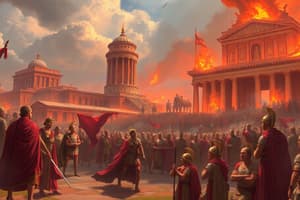Podcast
Questions and Answers
What were the two major empires that dominated most of Europe, North Africa, and the Middle East between the birth of Christ and the early seventh century?
What were the two major empires that dominated most of Europe, North Africa, and the Middle East between the birth of Christ and the early seventh century?
- Rome and Iran (correct)
- Byzantium and Carthage
- Greece and Persia
- Rome and Egypt
Which geographical feature marked the boundaries of the Roman Empire to the north?
Which geographical feature marked the boundaries of the Roman Empire to the north?
- The Sahara Desert
- The Rhine and Danube Rivers (correct)
- The Euphrates River
- The Mediterranean Sea
What was the role of the Mediterranean Sea in relation to the Roman Empire?
What was the role of the Mediterranean Sea in relation to the Roman Empire?
- It served as a barrier against invasions.
- It was the main trade route for neighboring empires.
- It was the heart of Rome’s empire. (correct)
- It isolated Rome from eastern territories.
Which of the following items are typically discovered by archaeologists during excavations?
Which of the following items are typically discovered by archaeologists during excavations?
What significant historical rivalry is mentioned concerning the Roman Empire?
What significant historical rivalry is mentioned concerning the Roman Empire?
Flashcards are hidden until you start studying
Study Notes
Roman Empire Overview
- The Roman Empire spanned most of Europe, parts of the Fertile Crescent, and North Africa.
- The empire included diverse local cultures and languages, showcasing its vastness and complexity.
- Women had stronger legal rights during the Roman period compared to many modern countries.
- The economic system heavily relied on slave labor, resulting in significant loss of freedom for many individuals.
Decline and Legacy
- From the fifth century onwards, the western part of the empire began to collapse, while the eastern part remained intact and prosperous.
- The prosperity of the eastern Roman Empire laid the foundation for the subsequent caliphate, which inherited urban and religious traditions.
Historical Sources
- Roman historians utilize three main types of sources: texts, documents, and material remains.
- Textual Sources: Include Annals (yearly narratives), letters, speeches, sermons, and laws.
- Documentary Sources: Primarily consist of inscriptions and papyri. Inscriptions in Greek and Latin are often found on stone, while papyrus, sourced from a Nile plant, was widely used for everyday writing.
- Material Remains: Encompass various archaeological findings like buildings, monuments, pottery, coins, and landscapes, often uncovered through excavation.
Interaction with Other Empires
- During the era from Christ's birth to the early 7th century, Rome and Iran dominated much of Europe, North Africa, and the Middle East.
- The Romans and Iranians were historical rivals, engaging in numerous conflicts over territory.
- The Euphrates River separated the two empires, acting as a geographical barrier.
Geographic Context
- The Mediterranean Sea was central to Roman expansion, linking Europe and Africa.
- Rome exerted control over regions surrounding the Mediterranean, bordered in the north by the Rhine and Danube rivers and in the south by the Sahara Desert.
- Iran held territories south of the Caspian Sea and parts of eastern Arabia, including significant areas of Afghanistan.
- The Roman and Iranian empires encompassed much of the known world, contrasting with the distant Chinese empire referred to as Ta Ch’in.
Studying That Suits You
Use AI to generate personalized quizzes and flashcards to suit your learning preferences.




